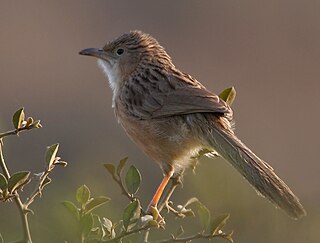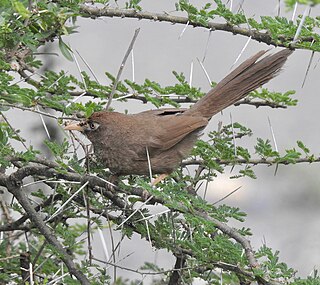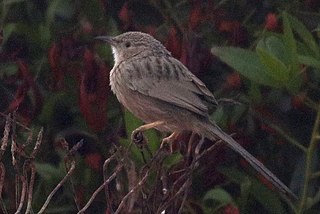
Amotz Zahavi was an Israeli evolutionary biologist, a Professor in the Department of Zoology at Tel Aviv University, and one of the founders of the Society for the Protection of Nature in Israel. His main work concerned the evolution of signals, particularly those signals that are indicative of fitness, and their selection for "honesty".

The orange-billed babbler, also known as Ceylon rufous babbler or Sri Lankan rufous babbler, is a member of the family Leiothrichidae.

The jungle babbler is a member of the family Leiothrichidae found in the Indian subcontinent. Jungle babblers are gregarious birds that forage in small groups of six to ten birds, a habit that has given them the popular name of "Seven Sisters" in urban Northern India, and in Bengali, with cognates in other regional languages which also mean "seven brothers".

The yellow-billed babbler is a member of the family Leiothrichidae endemic to southern India and Sri Lanka. The yellow-billed babbler is a common resident breeding bird in Sri Lanka and southern India. Its habitat is scrub, cultivation and garden land. This species, like most babblers, is not migratory, and has short rounded wings and a weak flight and is usually seen calling and foraging in groups. It is often mistaken for the jungle babbler, whose range overlaps in parts of southern India, although it has a distinctive call and tends to be found in more vegetated habitats. Its name is also confused with Turdoides leucocephala, which is also known as white-headed babbler.

The ashy-headed laughingthrush is a member of the family Leiothrichidae. The laughingthrushes are a large family of Old World passerine birds characterised by soft fluffy plumage. These are birds of tropical areas, with the greatest variety in southeast Asia.

The rufous babbler is an endemic species of bird found in the Western Ghats of southern India of the family Leiothrichidae It is dark brown and long tailed, and is usually seen foraging in noisy groups along open hillsides with a mixture of grass, bracken and forest.

The common babbler is a member of the family of Leiothrichidae. They are found in dry open scrub country mainly in India. Two populations are recognized as subspecies and the populations to the west of the Indus river system are now usually treated as a separate species, the Afghan babbler. The species is distinctly long-tailed, slim with an overall brown or greyish colour, streaked on the upper plumage and having a distinctive whitish throat.

Turdoides is a genus of passerine birds in the laughingthrush family Leiothrichidae. The species are distributed across Africa and southern Asia and are typically fairly large, long-tailed birds which forage in noisy groups. The majority of species have drab brown or grey-brown plumage. Several species that were included in Turdoides in the past have been reassigned to Argya following a 2018 study that found multiple clades.

The Iraq babbler is a species of bird in the family Leiothrichidae, native to reed beds of the Tigris-Euphrates Valley. It is found in Iraq and south-western Iran.

The scaly chatterer is a species of bird in the family Leiothrichidae. It is also known as the bare-eyed babbler. It is found in Ethiopia, Kenya, Somalia, and Tanzania. Its natural habitat is subtropical or tropical dry shrubland.

The southern pied babbler is a species of bird in the family Leiothrichidae, found in dry savannah of Botswana, Namibia, South Africa, and Zimbabwe.

The striated babbler is a species of bird in the family Leiothrichidae. It is found in southern Asia from Pakistan to Myanmar.

The fulvous babbler or fulvous chatterer is a species of bird in the family Leiothrichidae. It is 25 cm long with a wingspan of 27–30.5 cm. It is warm brown above with very faint streaking on the crown and back. The throat is whitish and the rest of the underparts are pale brown.

The white-throated babbler is a species of bird in the family Leiothrichidae. It is endemic to Myanmar.

The slender-billed babbler is a species of bird in the family Leiothrichidae. It is found in Bangladesh, Nepal, Northeast India and possibly Myanmar. Its natural habitat is subtropical or tropical seasonally wet or flooded lowland grassland. It is threatened by habitat loss.

The rufous chatterer is a species of bird in the family Leiothrichidae. It is found in Ethiopia, Kenya, Somalia, Sudan, Tanzania, and Uganda. Its natural habitats are dry savanna and subtropical or tropical dry shrubland.

The Afghan babbler is a species of bird in the family Leiothrichidae. It is found from southeastern Iraq to south western Pakistan. It was formerly considered a subspecies of the common babbler.

Argya is a genus of passerine birds in the laughingthrush family Leiothrichidae. The species are distributed across Africa and southern Asia and are typically fairly large, long-tailed birds that forage in noisy groups. Members of this genus were formerly placed in the genera Turdoides and Garrulax.

The laughingthrushes are a family, Leiothrichidae, of Old World passerine birds. The family contains 133 species which are divided into 16 genera. They are diverse in size and coloration. These are birds of tropical areas, with the greatest variety in Southeast Asia and the Indian subcontinent. The entire family used to be included in the Old World babbler family Timaliidae.

Allofeeding is a type of food sharing behaviour observed in cooperatively breeding species of birds. Allofeeding refers to a parent, sibling or unrelated adult bird feeding altricial hatchlings, which are dependent on parental care for their survival. Allofeeding also refers to food sharing between adults of the same species. Allofeeding can occur between mates during mating rituals, courtship, egg laying or incubation, between peers of the same species, or as a form of parental care.






















